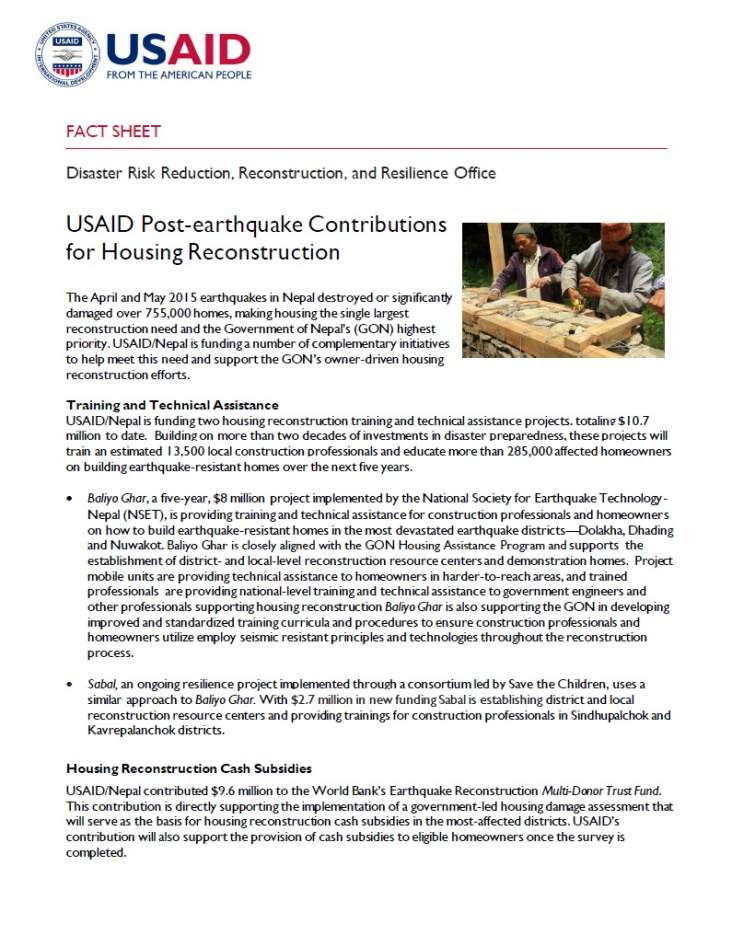Speeches Shim
The April and May 2015 earthquakes in Nepal destroyed or significantly damaged over 755,000 homes, making housing the single largest reconstruction need and the Government of Nepal’s (GON) highest priority. USAID/Nepal is funding a number of complementary initiatives to help meet this need and support the GON’s owner-driven housing reconstruction efforts.
Training and Technical Assistance
USAID/Nepal is funding two housing reconstruction training and technical assistance projects, totaling $10.7 million to date. Building on more than two decades of investments in disaster preparedness, these projects will train an estimated 13,500 local construction professionals and educate more than 285,000 affected homeowners on building earthquake-resistant homes over the next five years.
- Baliyo Ghar, a five-year, $8 million project implemented by the National Society for Earthquake Technology-Nepal (NSET), is providing training and technical assistance for construction professionals and homeowners on how to build earthquake-resistant homes in the most devastated earthquake districts—Dolakha, Dhading and Nuwakot. Baliyo Ghar is closely aligned with the GON Housing Assistance Program and supports the establishment of district- and local-level reconstruction resource centers and demonstration homes. Project mobile units are providing technical assistance to homeowners in harder-to-reach areas, and trained professionals are providing national-level training and technical assistance to government engineers and other professionals supporting housing reconstruction Baliyo Ghar is also supporting the GON in developing improved and standardized training curricula and procedures to ensure construction professionals and homeowners utilize employ seismic resistant principles and technologies throughout the reconstruction process.
- Sabal, an ongoing resilience project implemented through a consortium led by Save the Children, uses a similar approach to Baliyo Ghar. With $2.7 million in new funding Sabal is establishing district and local reconstruction resource centers and providing trainings for construction professionals in Sindhupalchok and Kavrepalanchok districts.
Housing Reconstruction Cash Subsidies
USAID/Nepal contributed $9.6 million to the World Bank’s Earthquake Reconstruction Multi-Donor Trust Fund. This contribution is directly supporting the implementation of a government-led housing damage assessment that will serve as the basis for housing reconstruction cash subsidies in the most-affected districts. USAID’s contribution will also support the provision of cash subsidies to eligible homeowners once the survey is completed.
Communications and Outreach
Timely, coordinated communications to affected homeowners is vital to ensure they know how to access reconstruction services and build back safer. USAID/Nepal is meeting this critical need through the following:
- With $400,000, the National Democratic Institute is supporting the GON to develop and implement a strategic communications plan that includes messaging for earthquake recovery and reconstruction.
- The Baliyo Ghar project is supporting a campaign to raise awareness among Nepalis about the importance of hazard-resilient reconstruction and safer construction techniques. Components of the campaign include street drama and outreach through radio and television stations, social mobilizers, print and online media.
- With USAID support, BBC Media Action is using radio, social media, and other platforms to share simple, actionable information regarding shelter and housing reconstruction, including where to access services and resources.
- USAID’s Sajhedari Bikaas project uses local and national radio and works with District Disaster Relief and Village Development Committees in six earthquake-affected districts to share reconstruction messaging from both USAID and the GON.


Comment
Make a general inquiry or suggest an improvement.